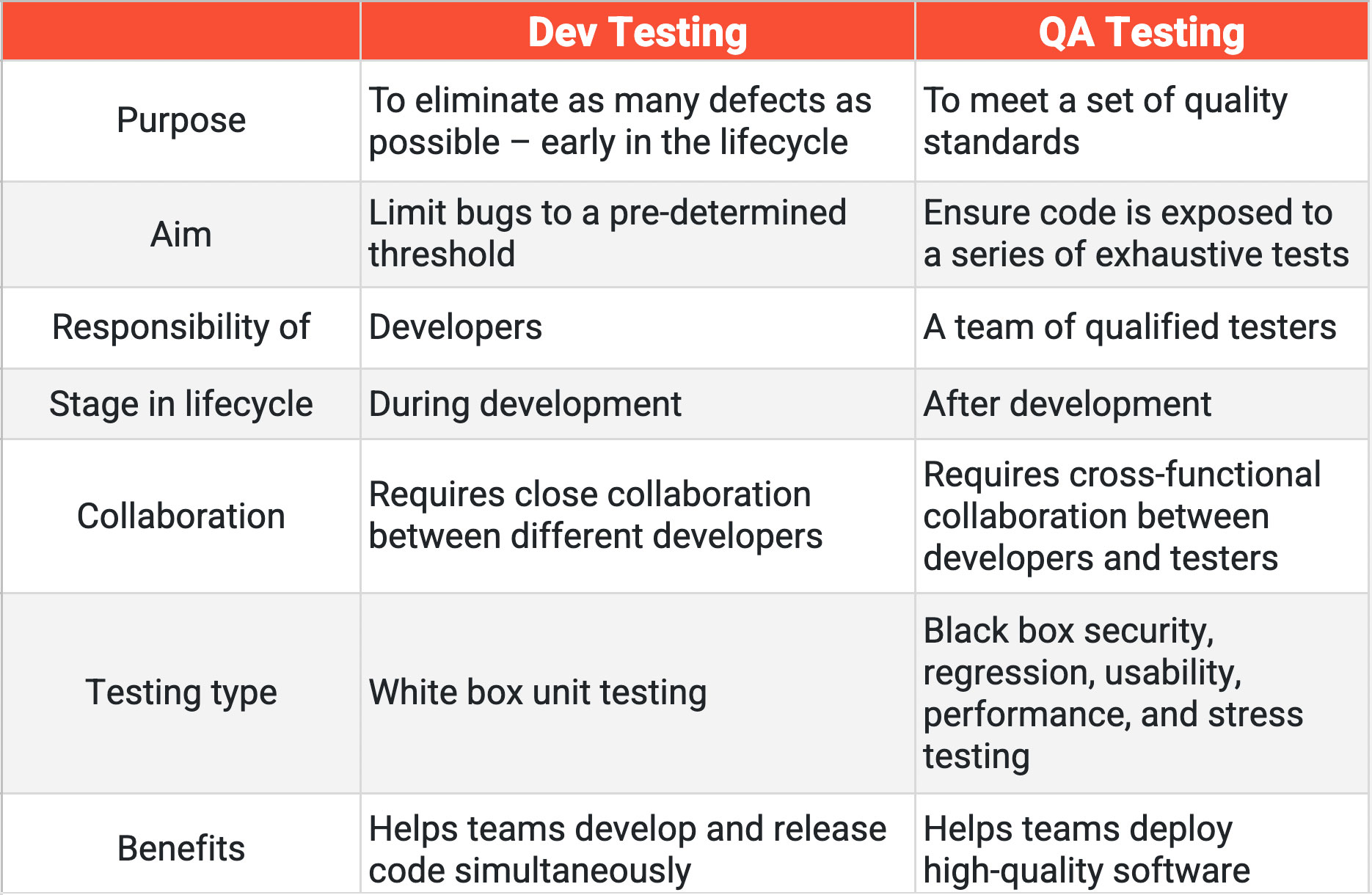Set your QA and Dev teams up for success by understanding the different approaches to quality assurance testing. In this article, we’ll compare QA and Dev testing and explain the advantages (and disadvantages) of both types of testing to help you prepare for your next sprint.
There’s something special about software quality assurance engineering (QA) that makes testers tick. My job as a QA tester is to identify flaws and breakdowns in software code using predefined quality standards and processes. I gravitate to the user-focused approach to problem solving. I like finding and reporting bugs. I enjoy stress-testing releases. And I love to do this work with other like-minded engineers.
Testers collaborate with developers to build, test and release new software. Both roles share a responsibility to deliver high-quality products that users love. Yet, the approach to quality by testers and developers varies significantly.
Understanding the different approaches to quality assurance testing is a critical first step to setting QA and Dev teams up for success. In this article, I explain key differences between QA and Dev testing, as well as the advantages (and disadvantages) of both types of testing to help you prepare for your next sprint.
Let’s take a look.
What is Software Quality Assurance?

Before we get started, let’s clear up some terms.
Software Quality Assurance (SQA): SQA includes the procedures, practices, and techniques that software must pass in order to align with compliance requirements and quality standards (like ISO 9000 and CMMI model). SQA plans typically include the full scope of configurations, reporting, methodologies and tools.
Developer (Dev) Testing: Developers perform a series of tests during the software development cycle. By establishing detailed, well-managed processes, Dev testing ensures that any code released into production undergoes thorough testing and review and meets quality standards. Testing while developing software minimizes release issues, customer defects and system downtime.
Quality Assurance (QA) Testing: Testers work as a team to identify, isolate, target and report bugs. Testers collaborate closely with developers by consistently delivering feedback on the quality of code according to pre-defined industry standards. They also have a knack for shifting gears with changing needs, evolving test suites in line with current trends, and providing the required documentation for training and customer use.
QA Testing vs. Dev Testing: What’s the Difference?

As a QA tester, I can recall times when my relationship with developers became strained because we disagreed on how to go about testing. The developers wanted to test the code during the development of the software; I wanted to test after release. As a tester, I was more focused on user requirements, while the developers focused on the technical nuances of software design. These equally valid, yet distinctly different approaches to testing can create blockers.
Both QA testers and software developers execute tests in some capacity; however, the approach, depth, timing and scope of testing varies drastically between the roles. Here’s how:
Approach
Developers will be most familiar with code they’ve produced, but this doesn’t always make them the best judge of whether the code is performing as expected. While Dev testing can greatly reduce the number of bugs or defects, developers can easily slip into pitfalls by relying on their own knowledge of the code and deviating from the user’s perspective when setting goals.
QA testers implement tests through the user’s lens and make evaluations based on real-time requirements. As developers continue to release updates over time, testers serve as quality control, ensuring that new features are working, existing features aren’t breaking and legacy features are phased out without derailing the user experience.
Depth
In many cases, a developer will be limited to building specific modules, or they may inherit legacy code. A developer’s history with the product will determine how well they understand the software they’re working with. Dev testing can go wrong when the developer doesn’t have insight into how their code affects the larger system, or because they know the system so well, they test with tunnel vision.
QA testers are typically more equipped to problem solve software breakdowns because they extensively study product functionality and service manuals as part of their training. Additionally, testers are also responsible for creating the step-by-step documentation needed to troubleshoot most issues, making them intimately familiar with how the product should work. The logs and reports that testers create when detecting bugs and glitches provide a historical record of work that comes in handy for future testing.
Timing
When it comes to productivity, Dev testing can slow down the development cycle with more checks and balances, yet increase time-to-market by eliminating most bugs on the spot. The code will be stable by the time QA testers get their hands on the product if the developer has done their due diligence.
QA testers typically conduct tests once the code is in a stable, or near stable state, which allows them to focus on in-depth, and sometimes repetitive, troubleshooting tasks. If you’re on a tight timeline, this could be problematic. QA testers are more focused on solving issues without the constraints of time, while simultaneously developing test case templates and scripts, as well as automated workflows that can speed up future test scenarios.
Scope
There is one major disadvantage of QA testing. It is quite common for code or project requirements to change. While this is frustrating for the entire team, it can especially affect QA testers. Such changes can result in delays when testers need to reconfigure the scope of their testing. Even the smallest change to a codebase must be run through multiple tests to ensure its stability and compatibility with existing code.
Dev testing is priceless in this scenario. By testing updates on the spot, developers can implement immediate solutions and limit down time while testers recalibrate.
Which is Better?

Understanding the difference between QA testing and Dev testing ensures that software products meet quality and compliance standards.
The table below, compliments of Synoptek, illustrates the key differences between Dev and QA testing.

Dev Testing and QA Testing: What’s the Difference? | Synoptek
Closing Considerations

Organizations and software teams with bootstrap budgets may be tempted to forgo hiring qualified QA testers to vet their software products and pass the buck onto developers to do the testing. However, this approach is problematic and can have long-term consequences, including decreased productivity, increased costs and faulty releases.
Teams should strike the right balance between QA Testing vs. Dev Testing to save time and create more reliable software. When Dev teams implement a basic set of tests, they should share the code with the QA team, who will scrutinize it for bugs and issues.
This type of partnership sets the foundation of quality software development that meets the evolving needs of users, while answering changing business and market trends.
Even the best QA and Dev teams cannot guarantee 100% bug-free software. However, an independent testing team, like QualityWorks, will ensure that the software is user-friendly and of superior quality. Learn more about our end-to-end testing solutions.
About the Author
Andrew Lawrence is an ISTQB Certified QA Consultant at QualityWorks Consulting Group. He enjoys keeping up with the latest software test design and testing methodologies and has helped organizations improve test strategies for both web and mobile applications. Andrew is passionate about test automation, artificial intelligence and discovering new ways to streamline quality assurance processes.
